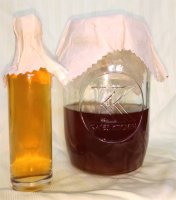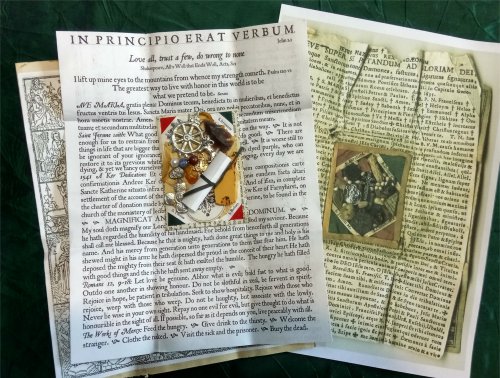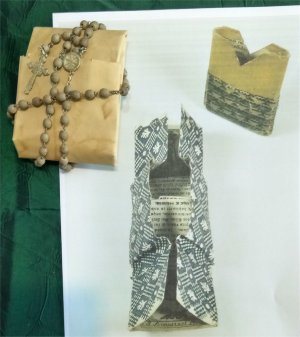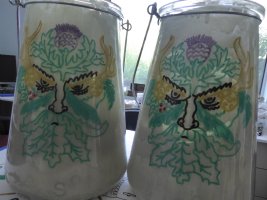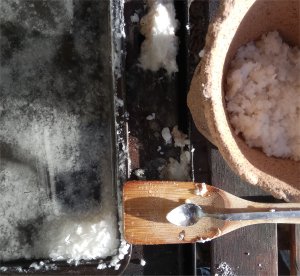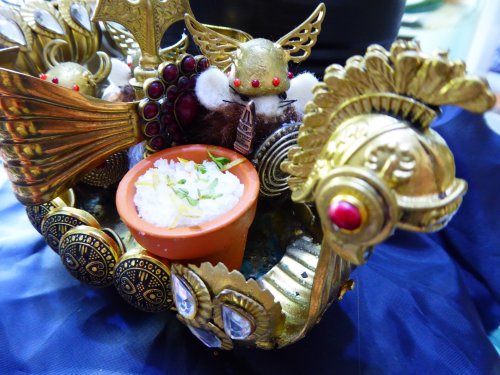 |
|
A&S Challenges: StuffMateria Medica CabinetAqua de Lavanda, Amulet, Soul Cakes Puppet Towers, Green Man Lanterns Spindle Whorls Sounding Line, Kamal Navigation Tool, Salt Production Rat Stuff: Death of Rats, Tray and Tableware, Ratbags and other Embroidered Items Other A&S Challenge Topics G9: Aqua de LavandaThis challenge was To gild refined gold, to paint the lily, To throw a perfume on the violet, ie to produce things for one's toilette. A lady of worth should smell sweet, so it is a pleasure to use plants from the garden and spices from the kitchen to make a tisane suitable for my hair, my face and my linens. I like having a nice-smelling spray when I'm ironing my linen garb, but the recipes for Queen of Hungary Water always seem chockful of ingredients. As a starter, I decided to try Aqua de Lavanda, from Gioventura Rosetti's Notandissimi Secreti de l'Arte Profumatoria, a book of 300 cosmetic recipes published in Venice in 1555 using relatively simple ingredients such as lavender, cinnamon and jasmine. Given my Venetian ties to the Mocenigo family, it seems appropriate that one of the two surviving copies of Rossetti's work is held in the Palazzo Mocenigo in Venice (home to a lovely cosmetics and costume museum). I based my redaction off one undertaken by Donna Heodez Sofonisba de Talento Minotto from her Segreti del Pavone website.
I poured 2/3C of aqua vitae (in this case plain vodka) over 1/2C of dried lavender flowers from my garden, and let the mix steep in a screw-top jar for three days. (Countdown had jars with my KK sigil on them!) To the resulting dark brown solution, I then added 1/4C of rosewater, 3 sticks of cinnamon and 6 cloves; I didn’t want the water to be too dominated by lavender. Rosetti then has the liquid distilled in an alembic, which I didn't have. So, following the good Donna's approach, I sealed the jar tightly and placed it in a pot of gently simmering water for around 15 minutes. The jar's metal lid showed a pleasingly indented form, indicating it was sealed with a partial vacuum. From there it went into a dark cupboard for four weeks. The mess was strained to remove the soggy lavender and spices; the coffee plunger did well for this! It produced a dark honey-coloured tincture. The scent is on the spicy, rather than lavendery side, much to my approval. For use, the tincture gets diluted with water or rosewater, to a general ratio of 1:3 or 1:4. Here's an English herbal linen freshener from the Segreti del Pavone website. A even-simpler version has 2TBsp of vodka mixed with 6-10 drops of essential oil in a 60-120ml spray bottle topped up with water. G11: Get thee to a nunnery : A Breverl or Spiritual AmuletI have a small amulet to bring me luck and protect me from evil. It holds some little charms I have collected - pilgrim tokens, an elf-arrow, a petal from the first rose my consort won for me - as well as prayers and my favourite saints’ names. The priests, neither of the Old Faith nor the new Kirk, do not like these, so it stays in a coffer, rather than worn around my neck as of old. Amulets, talismans and charms -- yes they are different things -- have a very long history, it seems back as far as we can recognise humankind. In 16th-century Europe religious reforms and fervour had not succeeded in stamping out such practices with paper amulets proving popular in Germany, Austria and Italy (variously known as breverl, esszettel, chartulas, cantigas breverl). One form which remained popular (versions can be found to this day) is that of the breverl, breve, or brevu relating to the short text and reminders it contained (the term surviving in this usage in the legal term brief). They typically consist of a couple of pages of folded written or printed text such as prayers, accompanied by woodcuts of saints or the Holy Family, and a selection of tiny charms such as crosses, pilgrim tokens, hair, herbs, pebbles or gems and the like. These were carefully folded together and housed in small bags of leather, silk or metal; later, pasteboard slipcovers became common and Cellini drew designs for jewelled versions (Skemer, pg 160). The text contained prayers, written charms or magic words aimed at protecting the wearer, initially from plague, but just as much from temptation and sin, and also from more mundane concerns such as cramp or lightning strikes. Sometimes a small roll of paper or parchment would contain a list of saints or intercessionary prayers, or there would be a print of the Pestkreuz (a cross to protect against the plague), often surrounded by protective saints or magic charms. St Thomas Aquinas approved of some types of amulets, and the witch-hunting tome Malleus Maleficarum recommended that the inquisitor wear one to protect against the spells of witches (Skemer, pg 66). A late 15C textual amulet roll held by Ishaw Collect (MS29) has annotations by Henry VIII and displays the heraldic arms of a bishop. Perhaps not surprisingly, Martin Luther railed against the practice in the late 1530s, saying it was "a frightful misuse and a piece of witchery to write the words In principio erat verbum on a slip of paper as a charm against thunder and storm" (Skemer, pg 67). Although the Church in all its forms came to frown upon these, they remained a staple of religious markets, predominantly popular in Germany, Italy and Austria. I was pleased to find a Scottish reference to their use, with John Ruthven (he of the Gowrie Conspiracy) wearing one, though it clearly didn't aid him in his attack on James VI (Skemer, pg 134, footnote). There is mention of ensuring that the amulets were locked like letters to retain their ju-ju (Skemer, pg 145). Once opened, their divine powers were said to vanish; one rare extant version was opened to find the magic text page was blank! Oddly enough, the text in these contain mnemonics for various prayers/devotions -- it's hard to see how useful they could be if the amulets weren't actually consulted....
My textual amulet (to use the technical academic term) contains inspirational quotes I like, the Baronial Oath, a list of virtues, as well as some Biblical verses and prayers. For the Scots touch there are conversion units for Scottish money, weights and measures, and an extract from a 1541 church dedication record for Andrew Ker of Fernihirst (12 pounds donated to St Catherine's altar!). The woodcut of the saints is a 1488 one by Domenec showing at top the 15 mysteries of the rosary and Christ's life; in the bottom half is St Dominic, St Thomas Aquinas, and St Catherine of Alexandria, surrounding the Madonna and Child. The extant versions were backed with printed art papers which looked a little modern to my eye so I backed mine with some parchmenty paper. The roll of saints starts with ones that katherine venerates: St Jerome, St Barbara, St Katherine, St Dominic and St Thomas. It also includes the canonical Hours.
The charms include a collection of tokens: a St Thomas clover leaf from the Coronation I co-stewarded; a St Katherine wheel from Ildhafn; an Alan Garner-inspired flower-owl from one of the first quests I ran; and a lion from a Canterbury Faire feast, for St Jerome and my lord-husband Bartholomew. Also a milagros cross, a broken Kingdom award (Prix Jongleur), a flint arrowhead, some amber chips and a set of my Kingdom triple gems; a gold wooden tower crafted by my son Pippin when he was a wee lad. All these are backed by dried rose petals from the May Crown Rose Tourney where Sir Radbot fought for me. As with the extant examples, these charms have been glued to a card with four saints' names and scrap silk in red and green across the corners. The extant versions I have been able to track down thus far are from the 1650s-1720s. Period references mention silk or leather bags, rather than the pasteboard slip-cover of the later versions. I intend to make a small taffetta bag in "katherine green" to hold my amulet, but in the meantime I have tucked it together in a letter-locked style to hold things in place, and keep wrapped around it a rosary from the Vatican, a gift from Sir Inigo. Let's hope it brings me luck! (Though I guess this is the kind of amulet the Invocation Court at Crown Tourney urges us to abjure!) References G1: Soul Cakes, Soul Cakes, please good Mistress a Soul CakeBeing the challenge: 1. Do you think because you are virtuous, that there shall be no more cakes and ale? And thus the call went out: For that it lies near the Feast of All Souls Day and for that said day is the Natal Day of the lovely Lady Vigdis, know that the November Monthly Tourney on the iiid day of said month shall be graced by Soul Cakes for the sustance of all. And further, the aforementioned month occasioning the Feast Day of St Catherine upon the xxvth day, there will be Cattern Cakes for my saint's name's sake. For those not approving of the old saints, then it is a day in especial honour of lace-makers and the Queen. I wanted to encourage activities at the barony's monthly tourneys which didn't revolve around the fighting. Everyone likes cakes so.... Soulmass cakes were traditionally baked to celebrate All Hallows E'en and All Souls' Day at the beginning of November. The small cakes are filled with spices and currants, and usually have a cross marked on them. I used a recipe redacted from that of Lady Elinor Fettiplace (1604), based on the Durham Dark Ale Soul Cake by Ladan Cockshut. Cattern cakes are similar but have caraway seed for flavouring, rather than spices. They are associated with St Katherine of Alexandria or, in England, with Queen Katherine of Aragon, who was said to have destroyed her lace to give employment to the local women, as attested thusly: Queen Katherine loved to deck with lace In France unmarried women over the age of 25 were called "Catherinettes". They consoled each other on their lack of a spouse, singing: A husband, St. Catherine! Their friends would make them yellow or green hats, so they might demonstrate their faith and wisdom, respectively. Another French reference says that before a woman reaches the age of 25, she prays: Donnez-moi, Seigneur, un mari de bon lieu! Qu'il soit doux, opulent, libéral et agréable! (Lord, give me a well-placed husband. Let him be gentle, rich, generous and pleasant.) After 25, she prays: Seigneur, un qui soit supportable, ou qui, parmi le monde, au moins puisse passer. (Lord, how about one who's bearable, or who can at least pass as bearable in the world.) And when she's getting on towards thirty, the prayer is: Un tel qu'il te plaira Seigneur, je m'en contente. (Send whoever you want, Lord; I'll have him!) There are references to earlier celebrations when women dressed in male attire and indulged in "unfettered merry-making, including amorous (or violent) advances to passing men"! The cakes got eaten -- didn't notice any ladies in men's clothing though... This challenge tied into Gubbins 3 :When I am forgotten, as I shall be, and sleep in dull cold marble, … Say, I taught thee., encouraging the teaching or sharing of knowledge. For each monthly tourney I have been announcing various period activities or celebrations associated with the month. And at Canterbury Faire (AS54) I ran a class on Enriching an Event or how to make en event or activity richer in experience, education and entertainment. VPC2: Out of Your Comfort Zone: Puppet TowersI needed new towers for the puppet theatre at Canterbury Faire; the Head-onna-Stick players (Mistress Rowan and Master Nico) had been working with some cardboard ones recycled from a children's activity and they tend to fall over at inopportune times.
This project certainly took me out of my comfort zone -- I had to use power tools and -- worse -- ask an unknown neighbour for permission to raid his construction skip for some broken cedar shingles. When I looked at the shingles after I'd painted them to match 14C examples, I realised that circular saw marks were clearly visible. Master Edward Braythwayte confirmed this was a no-no to proper woodworker eyes, so I flipped them over and sanded them down to start again (more power tools!). And, to go with the up-grade, I made a period-style rainbow -- red with a white stripe -- to be sewn onto the rear scrim of the puppet theatre. Not sure why rainbows were depicted in this fashion but this seemed to be a relatively common motif across the 3-4 examples I have found of period puppet stages (eg Roman du bon roi Alexandre, Jehan de Grise, France 1344, Bodleian Library, detail shown). I did like the green towers I found later, maybe next time (13th Century, MS 251, Brugge).
VPC5: Here Be Monsters: Green Man LanternsBeautiful lighting, like that seen in the Ildhafn encampment, lends a really special air to a location. I’ve tried lots of various approaches over the years, mostly in the form of semi-disguised LED-based or solar powered lights, but none have really provided good lighting and the right colour/look. The Canterbury Faire site requires candles to be enclosed, and I found a couple of large hurricane glasses on sale ($4!). These are large enough to allow three candles to burn at once (giving enough candlepower), and tall enough to support candles of a length decent enough to last through the evening. Sir Sebastian suggested a wash of white inside the lantern for more comfortable illumination. They act as good markers for the large portable holes that hold the standards at the corners of the Green Man.
I decided to decorate them with a variant on the Green Man foliate head, to match the Green Man theme of my tent at Faire. This artwork is based on an earlier Faire T-shirt design by Lord Ronan mac Briain, with some small modifications by me (mostly the punga eyebrows, to bring in a Kiwi anachronism). This is one version of the Green Man, where the face and head is made up of foliage, rather being a face surrounded by foliage (sometimes called a Jack-in-the-Green) or the disgorging/spewing face where leaves and wines emerge from the mouth, sometimes the ears and nose as well. While variations in foliate heads have been carved all round Europe for the past two thousand years, it wasn’t until 1939 that the term “Green Man” was applied (by enthusiastic amateur folklorist Julia, Lady Raglan). The Romans had such heads, associated with Pan, Bacchus, Dionysus and Silvanus. Churches picked up the symbol from the 12C or thereabouts, taking its traditional symbology of rebirth and regeneration as representative of the Resurrection, carving them in ceiling bosses, misericords, grotesques and the like. VPC11: String Theory: Sounding Mark Twain Ho!My initial rush of blood to the head for the Variety Pentathalon Challenge saw me thinking about how my persona father no doubt spent some time at sea, so I could have a batch of small instruments that he picked up along the way. One such instrument is a sounding line; in this case, a model sounding line (I didn’t want to waste 25 fathoms or 150 feet of actual line).
Sounding comes from “sund”, Old English for swimming, water or sea. The sounding line or sounding lead has been used for centuries to measure the depth under the keel of your boat. Various marks, made out of leather, calico and other materials, at set intervals along the line provide a visual and – importantly during the night watches – tactile guide as to how far the line had been paid out. The plummet, a cylindrical lump of soft lead, with a convex bottom “armed” with something sticky like tallow or lard, provided a means of drawing up an indication of whether the sea bottom was rocky, sandy or muddy. My model sounding lead has the marks at the traditional lengths to scale (2,3, 5, 7, 10, 13, 15 , 17 and 20 fathoms), with the traditional materials and shapes used. The plummet is from a large sinker I had lying around, battered to give it a curved bottom. It’s not clear just when these materials or lengths came into standard use, but the sounding lead does predate many nautical instruments, and examples have been found in Greek and Roman shipwrecks. Olaus Magnus, in his History of the Nordic Peoples (1555, Bk 2, Ch 12) includes a woodcut of a a ship-based sailor and a landlubber both using sounding leads. Master Jackman on Sir Martin Frobisher's return voyage to England in 1578 noted that using an armed lead (these have a socket filled with wax or tallow to pick up bottom samples), he "sounded and had 70 faddems, oosy sand, whereby we judged us to be northwards of Scilly, and afterward sailed south east all that night". The ship rounded Lands End safely. VPC22: Oh Say, Can You Sea? : Kamal Navigation ToolArabs and the sea-farers of India use a simple stick- or card-based navigation device to determine their latitude while upon the waves. Vasco da Gama and the Portuguese spotted its utility and took it up during the exploratory period of the 1500s with use of the kamal being covered in at least two Portuguese pilot books of the early 16C. The original concept is thought to have come from finger-based reckoning where a finger held at arm’s length measures approximately 1.5 degrees. The kamal (a wooden card around 5cm x 2.5cm) is held out at arm's length matching the horizon at one end and the celestial centre of the sky at the other. Knots in the string are set for the latitudes of desired ports. Hold the right knot in your teeth and the alignment of the kamal will tell you your required course north or south. This worked well in the northern hemisphere as navigators knew that the star Polaris marked the north celestial pole and, hence, its elevation marked the latitude. Limitations on the size of the kamal meant that it worked best in equatorial waters where Polaris was reasonably close – 10-20 degrees -- to the horizon (hence its popularity in Arab areas). European navigators later developed the cross-staff based on similar principles adapted for higher latitudes. In this case, I used a stick to get the longer length needed for our higher latitude (42 degrees S) and the knot positions were calculated for the latitudes of the important settlements in the Crescent Isles. The aim is to measure against the position of the South Celestial Pole, not so easy, specially finding it above a flat sea horizon from the east coast of the Crescent Isles! Reference VPC14/20: Back To Basics and With the Grain: Salt ProductionThis challenge called on us to start with unprocessed elements and work towards an end product. This one took a while for me to complete, falling outside the challenge timeframe, but it proved a very interesting project indeed. Dorothy Dunnet, in her House of Niccolo series (read it!), has a memorable scene set in a hellish salt-making area. That, and a tour of the saltworks near Blenheim, has always had me intrigued in salt’s manufacturing process. The Romans used lead pans, which had the disadvantage of being prone to melting. The English ended up copying the Scottish practice with iron pans being adopted as new technology. Marco Polo came across salt coins, pressed and stamped with the face of the Great Khan. Mary Queen of Scots was apparently the first ruler to impose a salt tax, granting a patent to an Italian salt-maker in Scotland. Elizabeth I followed suit, granting salt-related patents in the 1560s, trying to give local salt an edge over imported. Norwich was a well-known salt production area, as evidence by the wich suffix in its name. (See references below.) My son and his friends were heading for Taylor’s Mistake, which has the best environmental rating for beach water quality in Canterbury. So I asked him to get out beyond the breakers and collect me 32 litres of clean seawater, preferably at slack tide.I let it sit to settle, then filtered the seawater a couple of times to remove sand, seaweed and other small bits of debris. Then heated up a batch in an old roasting pan on the barbeque.
My preference would have been to make up a rectangular fire pit in the backyard and use a much larger tray, but there are restrictions on that sort of thing and I didn’t want to alarm the neighbours. As the water boiled off, I added more seawater, and repeated this over and over and over until the water became a super-saturated solution as the crystal slurry formed. The 32 litres should have given me around 1.5kg of salt, but I only did around half this amount as after 8 hours or so it was getting dark and I was getting bored. In the final stage you have to watch it carefully to be sure it doesn't scorch. The oily saturated solution gets thicker until it reaches a wet sand consistency. I skimmed off the solids and packed them into a clay pot. Salt-making briquetage dates back to the Iron Age in the UK, and utilised pottery vessels strikingly similar in size and shape to a clay pot my mother had made. (And gave me a good reason for keeping the heirloom!) These pots were typically fired from below to further concentrate the brine, and eventually broken apart to produce the traditional salt cone. I wasn’t sure if Mum’s pot would cope with that, so left the brine to evaporate in the sun. The whole process produced around 500g of salt.
It is very salty briney salt, lovely with the addition of dried lemon zest and thyme, rosemary and bay leaf. The quantities were around 2 tsp of dried herbal mixture to a quarter of a cup of salt. The salt remained slightly damp and sandy in texture (no actual sand in it!), a bit like the very expensive high-end Fleurs de Sal. I used a mound of the salt for the High Table presentation at a Canterbury Faire beast feast, with my brass salt mouse nef sailing across a sea of salt. Now the flavoured grains can add a new taste to the feasts I attend. A chronicler tells the story of the corpse preserved by the salt, that was found in Dürrnberg on 30 November 1573. One winter month in the year of 1573 Reference
First Salt Making in Europe: an Overview from Neolithic Times
| ||||||||||||||||||||||||||||||||||||||||||||||||||||||||||||
